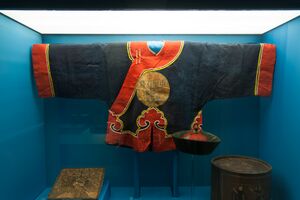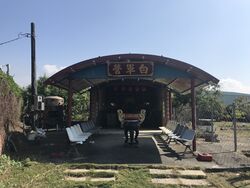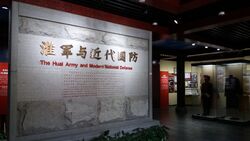جيش هواي
| جيش هواي Huai Army | |
|---|---|
| 淮軍 | |
| نشطة | 1862–1894 |
| البلد | أسرة تشينگ |
| النوع | ميليشيا شبه خاصة |
| الكنية | جيش آنهوي |
| المعدات | مزيج من الأسلحة التقليدية والحديثة (القرن التاسع عشر) |
| الاشتباكات | تمرد تايپنگ، الحرب الصينية الفرنسية، الحرب اليابانية الصينية الأولى |
| القادة | |
| أبرز القادة | لي هونگژانگ |
جيش هواي (الصينية: 淮軍; پنين: Huái jūn)، الذي سمي على اسم نهر هواي، كان قوة عسكرية متحالفة مع أسرة تشينگ نشأت لاحتواء تمرد تايپنگ في 1862. وكان يُطلق عليه أيضًا اسم "جيش آنهوي" لأنه كان مقره في مقاطعة آنهوي. لقد ساعد في استعادة استقرار أسرة تشينگ. على عكس جيش الراية الخضراء أو الرايات الثمانية لقوات تشينگ، كان جيش هواي إلى حد كبير جيش ميليشيا، قائماً على الولاءات الشخصية وليس المؤسسية. كان مسلح بمزيج من الأسلحة التقليدية والحديثة.
لي هونگژانگ، قائد في جيش شيانگ، أنشأ جيش هواي في أكتوبر 1861. نجح في جيش شيانگ. جيش هواي نفسه قد خلفه الجيش الجديد وجيش بـِيْيانگ، اللذان تم إنشاؤهما في أواخر القرن التاسع عشر.
التأسيس
قبل استعادة آنچنگ في أواخر عام 1861، أمر زنگ گووفان تلميذه لي هونگژانگ بإعادة بعض من جيش شيانگ إلى آنهوي، موطن لي هونگژانگ، للخدمة العسكرية وتنظيم قوة مستقلة تحت قيادة لي هونگژانگ. كان إجمالي قوتهم 25000 جندي، بما في ذلك بعض جنود تايپنگ في آنچنگ الذين استسلموا. جمع لي هونگژانگ هذه القوات في جيش واحد، وبعد ثلاثة أشهر من التدريب خاضوا معركتهم الأولى، معركة شانغهاي (1861).
كان لي هونگژانگ في القيادة العامة لجيش هواي، والذي كان جزءًا من السلسلة الجديدة من الجيوش الإقليمية المعروفة باسم Yong Ying، والتي تم إدخالها إلى الصين بعد تمرد نيان. على العكس من جيش الرايات الثمان المانشو أو جيش الراية الخضراء، لم يتم تناوب الضباط في هذه الجيوش الإقليمية؛ اختاروا الجنود تحت قيادتهم وأقاموا علاقات أبوية معهم. تم تجهيز هذه الجيوش بأسلحة حديثة.[1]
التاريخ
كما درس ضباط من جيش آنهوي مثل Ch'a Lien-piao (Zha Lianbiao) التدريبات العسكرية الغربية في الخارج في ألمانيا،[2]
كان الجنرال ژو شنگتشوان هو تؤونگ-لينگ/تونگلينگ (قائد) إحدى أفضل وحدات جيش آنهوي في زيهلي. شجع لي هونگژانگ على شراء أسلحة أجنبية حديثة.[3] أشاد الجنرال ژو بأبوية جيش آنهوي والعلاقات بين الجنود والضباط، والذي مارس أيضًا المحسوبية في وحدته.[4]
تم تنفيذ التدريبات العسكرية الغربية من قبل ژو، وتم تشجيع الضباط على المشاركة. تم تنفيذ المكافآت والعقوبات على الرماية الجيدة والسيئة على التوالي، مع "شارات الاستحقاق" والمال.[5]
كان ژو مهتمًا للغاية بالتكنولوجيا الحديثة مثل الطب والتلغراف والسكك الحديدية، وانتقد المستشار البريطاني غردون باشا لعدم التفكير في استخدامها على نطاق واسع في الحرب. انتقد ژو ضباط المدرب الألماني لي هونگژانگ بسبب افتقارهم إلى المعرفة بإطلاق النار والقتال في الليل. وأشاد الغربيون واليابانيون بقواته واعتبروا "من الدرجة الأولى". قال ژو إن "هواء الشفق" استقر على القوة بعد عقدين من الزمن، وتراجع أداؤها.[6]
تلقى ضباط الصف في جيش آنهوي "تدريباً خاصاً".[7]
أعطى لي هونگژانگ ضباط رفيعي المستوى في الجيش الأخضر القياسي في زيهلي إلى ضباط من جيش آنهوي.[8]
خدمت وحدات جيش آنهوي ضد الفرنسيين في Tonkin و Formosa خلال الحرب الصينية الفرنسية. على الرغم من أنهم كانوا منتصرين في بعض الأحيان، إلا أنهم خسروا معظم المعارك التي انخرطوا فيها.[9]
تمركزت قوات جيش آنهوي في مقاطعات مختلفة في جميع أنحاء الصين مثل زيهلي، شانشي، وهوبـِيْ، وجيانگسو، وشآنشي من قبل الحكومة، حوالي 45000 في المجموع. كما قاتلوا في الحرب اليابانية الصينية الأولى.[10]
مكنت قيادة الجنرال Liu Mingchuan جيش آنهوي الصينيين من مواجهة القوات الفرنسية في القتال في تايوان.[11]
عندما حاول الفرنسيون الاستيلاء على حصون Keelung التايوانية، والهجوم بالقرب من Tamsui، تعرضوا للضرب من قبل جنود آنهوي بقيادة الجنرال ليو.[12]
لم يكن معظم ضباط جيش هواي يحملون شهادات وألقاب رسمية، لأنه بعد إدخال التحديث في الجيش الصيني، بدأ المزيد من الناس العاديين بدلاً من العلماء في التجنيد في الخدمة العسكرية.[13]
ضباط
القادة الرئيسيون
القادة الثانويون
المصادر
- ^ John King Fairbank; Kwang-Ching Liu; Denis Crispin Twitchett, eds. (1980). Late Ch'ing, 1800-1911. Vol. 11, Part 2 of The Cambridge History of China Series (illustrated ed.). Cambridge University Press. p. 202. ISBN 0-521-22029-7. Retrieved 2012-01-18.
By the end of the Nien War in 1868, a new kind of military force had emerged as the Ch'ing dynasty's chief bulwark of security. Often referred to by historians as regional armies, these forces were generally described at the time as yung-ying (lit. "brave battalions"). In the 1860s such forces throughout all the empire totaled more than 300,000 men, They included the remnants of the old Hunan Army (Hsiang-chün) founded by Tseng Kuo-fan, the resuscitated Hunan Army (usually called Ch'u-chün) under Tso Tsung-t'ang, and the Anhwei Army (Huai-chün) coordinated by Li Hung-chang. There were also smaller forces of a similar nature in Honan (Yü-chün), Shantung, (Tung-chün), Yunnan (Tien-chün) and Szechwan (Ch'uan-chün). These forces were distinguished generally by their greater use of Western weapons and they were more costly to maintain. More fundamentally they capitalized for military purposes on the particularistic loyalties of the traditional society. Both the strength and the weakness of the yung-ying were to be found in the close personal bonds that were formed between the higher and lower officers and between officers and men. In this respect they differed from the traditional Ch'ing imperial armies--both the banner forces and the Green Standard Army.
- ^ John King Fairbank; Kwang-Ching Liu; Denis Crispin Twitchett, eds. (1980). Late Ch'ing, 1800-1911. Vol. 11, Part 2 of The Cambridge History of China Series (illustrated ed.). Cambridge University Press. p. 245. ISBN 0-521-22029-7. Retrieved 2012-01-18.
Ch'a Lien-piao, one of several Anhwei Army officers whom Li had sent to Germany for training during the 1870s, received Chou's special praise for expertise in Western drill.
- ^ John King Fairbank; Kwang-Ching Liu; Denis Crispin Twitchett, eds. (1980). Late Ch'ing, 1800-1911. Vol. 11, Part 2 of The Cambridge History of China Series (illustrated ed.). Cambridge University Press. p. 244. ISBN 0-521-22029-7. Retrieved 2012-01-18.
Li seems to have left the training of the Anhwei Army troops to two or three high commanders (t'ung-ling) in Chihli, among whom Chou Sheng-ch'uan (1833-85) was the most energetic and conscientious. A veteran of the Taiping and Nien wars, Chou in the 1870s commanded the best-equipped detachment of the Anhwei Army, with usually more than 10,000 men under him. Like Li, Chou placed great emphasis on modern weapons. Quite knowledgeable about them, he repeatedly recommended that Li purchase Krupp cannon, Remington, Snyder and other modern rifles, Gatling guns and the like. His petitions to Li and instructions to his own troops indicate his awareness of the need not only to acquire and to keep in good condition new Western weapons, but also to provide systematic training in their use.
- ^ John King Fairbank; Kwang-Ching Liu; Denis Crispin Twitchett, eds. (1980). Late Ch'ing, 1800-1911. Vol. 11, Part 2 of The Cambridge History of China Series (illustrated ed.). Cambridge University Press. p. 246. ISBN 0-521-22029-7. Retrieved 2012-01-18.
Chou lauded the paternalism and interpersonal rapport that characterized the Anhwei Army--in fact, he had staffed his detachment with many of his own relatives. Although he himself greatly admired the skill and knowledge of foreign-educated officers such as Ch'a Lien-piao, Chou seldom recommended them for the Green Standard titles and offices so coveted by the yung-ying officers.
- ^ John King Fairbank; Kwang-Ching Liu; Denis Crispin Twitchett, eds. (1980). Late Ch'ing, 1800-1911. Vol. 11, Part 2 of The Cambridge History of China Series (illustrated ed.). Cambridge University Press. p. 245. ISBN 0-521-22029-7. Retrieved 2012-01-18.
Unlike some other yung-ying commanders, Chou was also convinced of the advantages of Western-style instruction and drill. He not only produced manuals, but often personally supervised the drill of his troops and continually exhorted his battalion and company officers to take part in it, too. Money rewards and 'badges of merit' (kung-p'ai) were recommended for superior marksmanship ; poor performance was punished.
- ^ John King Fairbank; Kwang-Ching Liu; Denis Crispin Twitchett, eds. (1980). Late Ch'ing, 1800-1911. Vol. 11, Part 2 of The Cambridge History of China Series (illustrated ed.). Cambridge University Press. p. 245. ISBN 0-521-22029-7. Retrieved 2012-01-18.
Although Chou did not want to employ Western instructors for his force, he often solicited foreign advice. Yet he reacted defensively, at times defiantly, to foreign criticism. He was skeptical, for example, of much of Gordon's military advice when the Victorian hero returned to China during the Ili crisis of 1880, and he even took to task the German officers that Li employed in the 1880s for knowing too little of night fighting and the advantages of prone firing. At times Chou clearly misunderstood the point of foreign advice--for example, when he characterized Gordon's advocacy of mobile, guerrilla-like tactics as laughable. Yet his charge that Gordon underestimated the importance of sophisticated technology seems fair enough. Chou, like Li, had a sustained interest in applied sciences (especially medicine) and modern means of communication, including the telegraph and railway. At least by contemporary Chinese standards, the battalions under Chou's command constituted a first-rate force. Japanese, German, British and American accounts of his troops are basically favorable. Yet several times during the early 1880s Chou himself remarked that the force had declined, that after 20 years it had lost its sharpness and acquired a 'twilight air'. The problem lay not so much in equipment as in the yung-ying system for the selection and promotion of officers. The experienced officers, Chou complained, lacked vigour, while the new ones lacked knowledge. Although Chou repeatedly admonished his battalion and company officers to participate in drill as strenuously as their troops, the officers continued to resist such involvement. It was, they felt, degrading. Chou's own writings as well as independent foreign observations note this crucial
- ^ John King Fairbank; Kwang-Ching Liu; Denis Crispin Twitchett, eds. (1980). Late Ch'ing, 1800-1911. Vol. 11, Part 2 of The Cambridge History of China Series (illustrated ed.). Cambridge University Press. p. 541. ISBN 0-521-22029-7. Retrieved 2012-01-18.
In 1853 Tseng Kuo-fan introduced special training for the non-commissioned officers of his new Hunan Army, emphasizing endurance and discipline. This was later imitated by the Anhwei Army. The technical training of the officer corps along western lines was begun in 1852 at Shanghai and Ningpo, where a few company commanders and their men were trained in the use of Western equipment and tactics by French and English military advisers.
- ^ John King Fairbank; Kwang-Ching Liu; Denis Crispin Twitchett, eds. (1980). Late Ch'ing, 1800-1911. Vol. 11, Part 2 of The Cambridge History of China Series (illustrated ed.). Cambridge University Press. p. 244. ISBN 0-521-22029-7. Retrieved 2012-01-18.
Soon after arriving in Chihli in 1870, Li began to integrate Chihli's Western-trained military forces into his own military organization, hopeful of putting these local resources to more effective use. He began with the 6,000 or so Green Standard lien-chün troops of the province, attempting to provide them with the same kind of drill and instruction as were available to his own men. He also secured the appointment of Anhwei Army commanders as high officers of the province's Green Standard system, in each case with Peking's approval. Ch'ung-hou's foreign arms and cannon corps, which Li inherited, was given retraining. Li refortified Taku and built a strategic walled city fronting the river ten miles form the estuary. He also expanded the Tientsin Arsenal, having been allocated funds for the purpose from the Tientsin maritime customs.107
- ^ John King Fairbank; Kwang-Ching Liu; Denis Crispin Twitchett, eds. (1980). Late Ch'ing, 1800-1911. Vol. 11, Part 2 of The Cambridge History of China Series (illustrated ed.). Cambridge University Press. p. 244. ISBN 0-521-22029-7. Retrieved 2012-01-18.
During the Sino-French War on 1884-1885, the Anhwei Army fought in both Tongking and Taiwan, and in the conflict with Japan in 1894-5, Li's troops saw action on every major front.
- ^ John King Fairbank; Kwang-Ching Liu; Denis Crispin Twitchett, eds. (1980). Late Ch'ing, 1800-1911. Vol. 11, Part 2 of The Cambridge History of China Series (illustrated ed.). Cambridge University Press. p. 244. ISBN 0-521-22029-7. Retrieved 2012-01-18.
By 1871, the Anhwei Army numbered nearly 45,000 troops, of which 13,500 were stationed in Chihli. The rest were located, as directed by the throne, in Shansi (3,000), Hupei (3,500), Kiangsu (4,500) and Shensi (20,000). In subsequent years, Li's troops continued to serve as the major defence force not only in Chihli, but also in several other provinces, in each case under the control of the top official of the province. During the Sino-French War on 1884-5, the Anhwei Army fought in both Tongking and Taiwan, and in the conflict with Japan in 1894-5, Li's troops saw action on every major front.
- ^ John King Fairbank; Kwang-Ching Liu; Denis Crispin Twitchett, eds. (1980). Late Ch'ing, 1800-1911. Vol. 11, Part 2 of The Cambridge History of China Series (illustrated ed.). Cambridge University Press. p. 252. ISBN 0-521-22029-7. Retrieved 2012-01-18.
Only on Taiwan were Chinese forces able to hold their own man-for-man against the French, thanks largely to the astute preparations by Liu Ming-ch'uan and the tactical ability of a few Anhwei Army officers.
- ^ John King Fairbank; Kwang-Ching Liu; Denis Crispin Twitchett, eds. (1980). Late Ch'ing, 1800-1911. Vol. 11, Part 2 of The Cambridge History of China Series (illustrated ed.). Cambridge University Press. p. 251. ISBN 0-521-22029-7. Retrieved 2012-01-18.
In early August, forces directed by Liu Ming-ch'uan, the famous Anhwei Army commander, repulsed an assault by Admiral Lespès aimed at the Keelung forts on Taiwan, and in October the French suffered another serious setback near Tamsui.
- ^ John King Fairbank; Kwang-Ching Liu; Denis Crispin Twitchett, eds. (1980). Late Ch'ing, 1800-1911. Vol. 11, Part 2 of The Cambridge History of China Series (illustrated ed.). Cambridge University Press. p. 540. ISBN 0-521-22029-7. Retrieved 2012-01-18.
the cases of Hunan particulartly illustrates this widespread militarization of the scholar class. . .Such was also the case of Liu Ming-ch'uan who rose form smuggling salt to leading an army in Anhwei, and finally to the governorship of the province of Taiwan (see chapter 4). . . Until 1856 most of the officers of the Hunan Army were scholars, The proportion dropped sharply for commissions given after this date. . . Holders of official titles and degrees accounted for only 12 per cent of the military command of the Huai Army, and at most a third of the core of the Huai clique, that is the top commanders of the eleven army corps.




